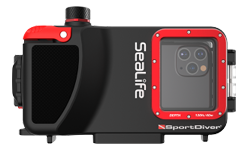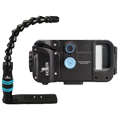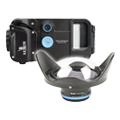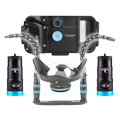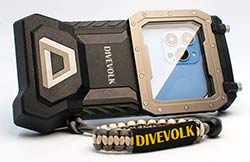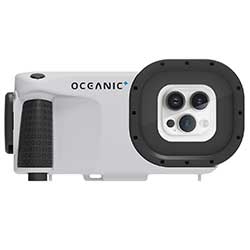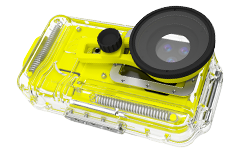Why Smartphones Could be the Future of Underwater Photo and Video

People have been talking about smartphones taking over the camera market for years. But will they actually become viable replacements for entry-level cameras, particular underwater cameras? For all intents and purposes, it's looking more and more like this could be the case. Earlier this year, Olympus sold its imaging business to Japan Industrial Partners (JIP). This was certainly ominous news for any compact or entry-level shooter as olympus cameras are particularly popular with new underwater photographers. JIP isn't exactly known for bringing back failing brands from the dead. In fact, their business model is often to create a lesser product focused on domestic markets in Japan. So with innovation of the Olympus brand out of the question, compact underwater photo shooters are left with the Sony RX100 lineup and the Canon G7X lineup as the top camera options. The Sony RX100 lineup tends to be fairly pricey and doesn't exactly cater to smaller budgets - though the performance of these cameras is excellent.

Purchase a smartphone housing at Bluewater Photo
Smartphone Camera Features
With options limited, it's time to take a serious look at a technology that is continuously being upgraded by some of the top tech companies in the world - the smartphone. A look at the release of the iPhone 12 Pro, it's clear that cell phone cameras are a good investment for any budding photographer. Phones lilke the iPhone 12 come with a triade of lenses including telephoto, wide, and ultrawide. Some phones now offer RAW files, 12 megapixel photos, manual shooting and even 4K video. Their sensors might not have the dynamic range or detail of a larger, compact camera sensor, but there's no denying that cell phone cameras have come a long way. Moreover, cellphones can do what every photographer wishes standard cameras could do - they have apps like instagram, facebook, and twitter. That means you can come up from a dive and send your photo that you just took off into the eternal sunshine that is the internet. Compact cameras are at a severe disadvantage as connectivity options are very limited comparitively.

Purchase a smartphone housing at Bluewater Photo
$424.00 | $763.99 | $1,992.97 |
Recommended Lens:
Latest Updates with Smartphone Dive Housings and Apps
New developments in smartphone diving housings have lead to some interesting applications allowing for more control over the smartphone while underwater, as well as alllowing for various apps to give us more details about our time underwater. These new developments can be seen in the following housings:
DiveVolk SeaTouch 4 Max underwater housing
The new DiveVOLK SeaTouch 4 MAX underwater housing is the world's first full-touchscreen underwater housing for smartphones. It is waterproof to 60 meters/196 feet and allows users to use all of the functions and apps on their smartphone underwater, just as they would on land.
The SeaTouch 4 MAX uses a unique touchscreen technology that is able to detect the user's touch even through the thick polycarbonate housing. This means that users can use all of the features of their smartphone, including the camera, social media apps, and even games, while underwater.
The SeaTouch 4 MAX also has a number of other features that make it ideal for underwater use, such as a built-in depth gauge, compass, and LED flashlight. It is also compatible with a variety of underwater accessories, such as external microphones and macro lenses.
Purchase a DiveVolk smartphone housing at Bluewater Photo
Oceanic+ Dive Housing
The Oceanic+ Dive Housing is a new underwater housing for the iPhone that turns it into a fully-functional dive computer and underwater camera. It is waterproof to 60 meters/196 feet and features a built-in depth gauge, compass, and timer. It also has a number of features that make it ideal for underwater photography, such as automatic color correction, RAW capture, and the ability to overlay dive data on photos and videos.
The Oceanic+ Dive Housing uses the iPhone's built-in sensors to track dive depth, time, and temperature. It also has a built-in algorithm to calculate decompression stops and other dive parameters. The dive computer information is displayed on the iPhone's screen in real time, so divers can easily monitor their dive and stay safe..
The Oceanic+ Dive Housing has a number of features that make it ideal for underwater photography. It has automatic color correction to compensate for the blue hue that is often found in underwater photos. It also has RAW capture mode, which gives photographers more control over their images in post-production. Additionally, the Oceanic+ Dive Housing allows divers to overlay dive data on their photos and videos, so they can share their underwater adventures with others in a unique and informative way.
In addition to its dive computer and underwater camera capabilities, the Oceanic+ Dive Housing also has a number of other features that make it a useful tool for divers. It has a built-in LED flashlight, which can be used to illuminate underwater scenes or signal to other divers. It also has a vacuum seal feature to ensure that the iPhone stays dry inside the housing.
Purchase an Oceanic+ smartphone housing at Bluewater Photo
How does underwater photo and video with a smartphone work?
To bring your smartphone to diving depths, you need to have an underwater housing. Thankfully, there are currently three excellent smartphone housing options - the Kraken Universal Smartphone housing (now on sale at Bluewater Photo), the SeaLife SportDiver iPhone housing and Nautismart SmartPhone Housing. Because smartphones are controlled with touch screens that can't be used underwater, smart phone housings come with a free app that connects the housing to the phone via bluetooth. Then when you push you shutter button or other controls on the housing, the app will tell your phone what to do. We've found that the phones connect fairly seamlessly. Kraken and SeaLife also work hard to improve their apps and add features like RAW files, some manual controls, etc.
Like any underwater camera, if you intend to take underwater photos and video with your smartphone, you're going to need video lights to capture the best colors. There are underwater camera treys available for smart phone housings where you can attach a video light. The video light will light up a scene with white light and you will get colors like reds, oranges, and yellows that are normally lost in the image due to light attenuation.
Smartphone housings are also compatible with wet lenses that can be screwed onto the front of the housing underwater. So if you want to take macro photos or get even closer to your subject for wide angle photos, there are lens options available. We recommend contacting Bluewater Photo to see what lens options are available with your smart phone housing.

Compact Cameras vs Smartphones for Underwater Photography
Pros of Smartphones
There is no denying that smartphones are the future of camera technology. We think that a smartphone housing is the best option if you are on a limited budget. Smartphone housings are fairly inexpensive and mostly universal. So if you upgrade your phone, you likely won't have to get another housing. They also come with a vacuum system to keep your phone safe. If you just want to take photos to share on social media, then a smartphone housing will save you the extra step of downloading and editing your photos - you can edit directly in the phone and send them out immediately from the phone. Cameras should have had this functionality a decade ago, but alas they do not.
Purchase a smartphone housing at Bluewater Photo
Cons of Smartphones
Ultimately, the image quality is still slightly better with a compact camera, but not by much. Because compact cameras have larger sensors, they tend to have slightly better dynamic range and details. The biggest benefit of shooting underwater with a compact camera is that you can attach an underwater strobe which is much more powerful than an underwater video light and will give you much better colors in your image. We hope that in the future smart phone housing companies will consider a way to trigger strobes using the built in camera flash on smartphones.

Conclusions
If you are serious about getting into underwater photography or video, ultimately it will be better to get a compact camera or mirrorless camera in the short term. But if you're on a budget and just want to take photos to share on social media, we highly recommend considering a smartphone housing.
RECOMMENDED ARTICLES
SUPPORT THE UNDERWATER PHOTOGRAPHY GUIDE:
The Best Service & Prices on u/w Photo Gear
 Visit Bluewater Photo & Video for all your underwater photography and video gear. Click, or call the team at (310) 633-5052 for expert advice!
Visit Bluewater Photo & Video for all your underwater photography and video gear. Click, or call the team at (310) 633-5052 for expert advice!
The Best Pricing, Service & Expert Advice to Book your Dive Trips
 Bluewater Travel is your full-service scuba travel agency. Let our expert advisers plan and book your next dive vacation. Run by divers, for divers.
Bluewater Travel is your full-service scuba travel agency. Let our expert advisers plan and book your next dive vacation. Run by divers, for divers.




